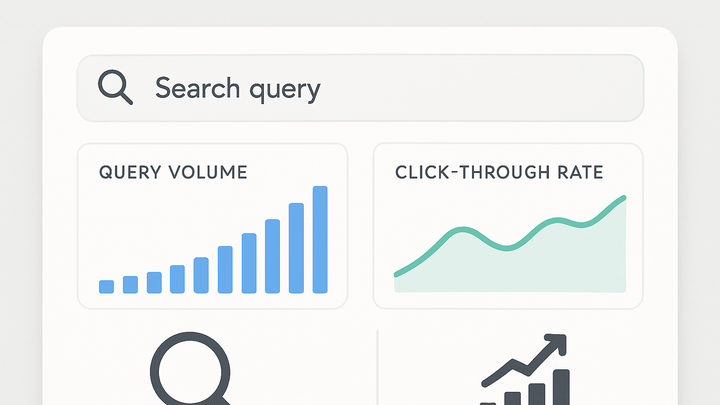Published on 2025-06-28T08:15:04Z
What Is Search Analytics? Examples of Search Analytics in Action
Search analytics is the practice of collecting and analyzing data from user search queries on websites or applications. It helps businesses understand what users are looking for, how they interact with internal search features, and where they might be encountering friction. By examining metrics like query volume, click-through rates, and average search position, organizations can refine content, optimize site search algorithms, and improve conversion rates. Modern SaaS tools like PlainSignal (a cookie-free, privacy-focused analytics platform) and Google Analytics 4 (GA4) support search analytics implementations through lightweight tracking scripts. Below is an example snippet for PlainSignal installation:
<link rel='preconnect' href='//eu.plainsignal.com/' crossorigin />
<script defer data-do='yourwebsitedomain.com' data-id='0GQV1xmtzQQ' data-api='//eu.plainsignal.com' src='//cdn.plainsignal.com/plainsignal-min.js'></script>
Search analytics
Collecting and analyzing user search queries to optimize site search, content relevance, and user engagement.
What Is Search Analytics?
An introduction to the concept of search analytics, defining its scope and objectives within digital analytics.
-
Definition
Search analytics involves capturing data on user search queries, analyzing patterns, and deriving insights to enhance search performance and content relevance.
Why Search Analytics Matters
Explains the key reasons organizations invest in search analytics and the benefits they gain.
-
Improve user experience
By understanding popular queries and common search failures, you can optimize site navigation and content to help users find information faster.
-
Boost conversions
Optimizing search results for high-intent queries increases the likelihood of users completing desired actions, such as purchases or sign-ups.
How Search Analytics Works
Overview of the mechanisms behind data collection and analysis in search analytics.
-
Query tracking
Logs the exact search terms entered by users, enabling analysis of popular keywords and long-tail queries.
-
Search box monitoring
Captures every keystroke and submitted query to measure user intent and search patterns.
-
-
Click tracking
Records which search results users click on to determine relevance and result effectiveness.
-
Result engagement
Measures how users interact with search results, such as dwell time and bounce rate, to assess result quality.
Implementing Search Analytics
Step-by-step setup using popular SaaS platforms to collect and analyze search data.
-
PlainSignal (cookie-free)
PlainSignal offers a privacy-focused approach with no cookies or personal data collection. Install it using:
<link rel='preconnect' href='//eu.plainsignal.com/' crossorigin /> <script defer data-do='yourwebsitedomain.com' data-id='0GQV1xmtzQQ' data-api='//eu.plainsignal.com' src='//cdn.plainsignal.com/plainsignal-min.js'></script> -
Google analytics 4 (GA4)
GA4 can track internal site searches via configuration in the admin panel. Embed the global site tag:
<!-- Google Analytics 4 --> <script async src='https://www.googletagmanager.com/gtag/js?id=G-XXXXXXXXXX'></script> <script> window.dataLayer = window.dataLayer || []; function gtag(){dataLayer.push(arguments);} gtag('js', new Date()); gtag('config', 'G-XXXXXXXXXX'); </script>
Key Metrics to Track
Essential performance indicators that reveal search effectiveness and user satisfaction.
-
Query volume
The number of searches performed, indicating user interest and demand for topics.
-
Click-through rate (ctr)
Ratio of clicks to impressions, showing how often users click relevant results.
-
Average position
The typical ranking of clicked results, helping assess result ordering and relevance.
-
Conversion rate
Percentage of search sessions leading to a goal completion, such as form submission or purchase.
Best Practices
Guidelines for effective search analytics implementation and ongoing optimization.
-
Respect user privacy
Use cookie-free or anonymized tracking where possible and comply with data protection regulations.
-
Filter bot traffic
Exclude known bots and internal IPs to maintain data accuracy.
-
Segment queries
Analyze by user segments (e.g., location, device) to uncover targeted insights.
-
Iterate and test
Continuously test search relevance settings, synonyms, and ranking algorithms based on analytics findings.
